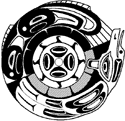
Phases of the Moon:
Planetarium show for Middle School Children
Pre-Show Activity 1
Motions of the Moon
Objectives
Students will be able to define the following terms: sidereal period, synodic period.
Grade Level
6 - 8
Materials
- Globes
- Tennis balls
- Flashlights
Background
The moon moves rapidly with respect to the background stars. It moves about 13 degrees (26 times its apparent diameter) in 24 hours---slightly greater than its own diameter in one hour! Its rapid motion has given it a unique role in the history of astronomy. For thousands of years it has been used as the basis of calendars. Isaac Newton got crucial information from the Moon's motion around the Earth for his law of gravity.
Procedure
- Distribute materials to groups of students.
- If you watch the Moon throughout the year, you will see the same face of the Moon all of the time. It is the ``man in the moon'', ``woman in the moon'', ``rabbit in the moon'' etc. One thing this shows you is that the Moon turns exactly once on its axis each time that it goes around the Earth. Later on you will find out how tidal forces have caused this face-to-face dance of the Earth and Moon. The Moon drifts eastward with respect to the background stars (or it lags behind the stars). It returns to the same position with respect to the background stars every 27.323 days. This is its sidereal period.
- Ask students to use models to show sidereal period. Encourage teams to talk about the orbit of the moon.
- One of the most familiar things about the Moon is that it goes through phases from new (all shadow) to first quarter (1/2 appears to be in shadow) to full (all lit up) to third quarter (opposite to the first quarter) and back to new. This cycle takes about 29.53 days. This time period is known as the Moon's synodic period. Because the Moon moves through its phases in about four weeks, the phases of new moon, first quarter, full moon, third quarter occur nearly one week apart from each other.
http://tycho.usno.navy.mil/vphase.html (will display in another window). A picture of the Moon will be shown.
- Ask students to use models to show synodic period. Encourage teams to talk about the differences between the two periods displayed in the lesson.
Follow Up
Ask the following questions to check for understanding:
- How does the Moon move with respect to the stars?
- How does the fact that we always see one side of the Moon prove that the Moon rotates once every orbital period?
- Why are New Moon phases longer than a sidereal period (27.3 days) apart from each other?
- In a particular year the Moon is in the constellation Aries on June 1st. What date will it be in Aries the next time?
- Why did the Apollo missions to the Moon always have landings on the same side of the Moon?
Some information on this page was copied from Nick Strobel's Astronomy Notes. Go to his site at www.astronomynotes.com for the updated and corrected version.
Source: Matt Merritt